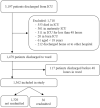Modified Early Warning Score as a predictor of intensive care unit readmission within 48 hours: a retrospective observational study
- PMID: 32667433
- PMCID: PMC7405753
- DOI: 10.5935/0103-507x.20200047
Modified Early Warning Score as a predictor of intensive care unit readmission within 48 hours: a retrospective observational study
Abstract
Objective: To evaluate the hypothesis that the Modified Early Warning Score (MEWS) at the time of intensive care unit discharge is associated with readmission and to identify the MEWS that most reliably predicts intensive care unit readmission within 48 hours of discharge.
Methods: This was a retrospective observational study of the MEWSs of discharged patients from the intensive care unit. We compared the demographics, severity scores, critical illness characteristics, and MEWSs of readmitted and non-readmitted patients, identified factors associated with readmission in a logistic regression model, constructed a Receiver Operating Characteristic (ROC) curve of the MEWS in predicting the probability of readmission, and presented the optimum criterion with the highest sensitivity and specificity.
Results: The readmission rate was 2.6%, and the MEWS was a significant predictor of readmission, along with intensive care unit length of stay > 10 days and tracheostomy. The ROC curve of the MEWS in predicting the readmission probability had an AUC of 0.82, and a MEWS > 6 carried a sensitivity of 0.78 (95%CI 0.66 - 0.9) and specificity of 0.9 (95%CI 0.87 - 0.93).
Conclusion: The MEWS is associated with intensive care unit readmission, and a score > 6 has excellent accuracy as a prognostic predictor.
Objetivo: Avaliar a hipótese de que o Modified Early Warning Score (MEWS) por ocasião da alta da unidade de terapia intensiva associa-se com readmissão, e identificar o nível desse escore que prediz com maior confiabilidade a readmissão à unidade de terapia intensiva dentro de 48 horas após a alta.
Métodos: Este foi um estudo observacional retrospectivo a respeito do MEWS de pacientes que receberam alta da unidade de terapia intensiva. Comparamos dados demográficos, escores de severidade, características da doença crítica e MEWS de pacientes readmitidos e não readmitidos. Identificamos os fatores associados com a readmissão em um modelo de regressão logística. Construímos uma curva Característica de Operação do Receptor para o MEWS na predição da probabilidade de readmissão. Por fim, apresentamos o critério ideal com maior sensibilidade e especificidade.
Resultados: A taxa de readmissões foi de 2,6%, e o MEWS foi preditor significante de readmissão, juntamente do tempo de permanência na unidade de terapia intensiva acima de 10 dias e traqueostomia. A curva Característica de Operação do Receptor relativa ao MEWS para predizer a probabilidade de readmissão teve área sob a curva de 0,82, e MEWS acima de 6 teve sensibilidade de 0,78 (IC95% 0,66 - 0,9) e especificidade de 0,9 (IC95% 0,87 - 0,93).
Conclusão: O MEWS associa-se com readmissão à unidade de terapia intensiva, e o escore acima de 6 teve excelente precisão como preditor prognóstico.
Conflict of interest statement
Figures
References
-
- Kramer AA, Higgins TL, Zimmerman JE. The association between ICU readmission rate and patient outcomes. Crit Care Med. 2013;41(1):24–33. - PubMed
-
- Aletreby WT, Huwait BM, Al-Harthy AM, Madi AF, Ramadan OE, Al-Odat MA. Tracheostomy as an independent risk factor of ICU readmission. Int J Health Sci Res. 2017;7(6):65–71.
Publication types
MeSH terms
LinkOut - more resources
Full Text Sources



